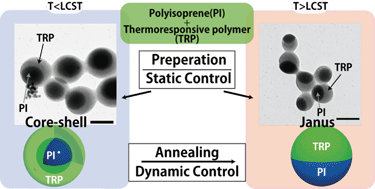Static and dynamic control of phase separation structures in nanoparticles of polymer blends
Abstract
This paper reports static and dynamic control of the phase separation structures of

* Corresponding authors
a
Graduate School of Engineering, Tohoku University, Japan
E-mail:
kiwamu@mail.tagen.tohoku.ac.jp
b Institute of Multidisciplinary Research for Advanced Materials, Tohoku University, Japan
c WPI Research Center, Advanced Institute for Materials Research, Tohoku University, Japan
d
Precursory Research for Embryonic Science and Technology, JST, Japan
E-mail:
yabu@tagen.tohoku.ac.jp
This paper reports static and dynamic control of the phase separation structures of

 Please wait while we load your content...
Something went wrong. Try again?
Please wait while we load your content...
Something went wrong. Try again?
K. Motoyoshi, A. Tajima, T. Higuchi, H. Yabu and M. Shimomura, Soft Matter, 2010, 6, 1253 DOI: 10.1039/B918164D
To request permission to reproduce material from this article, please go to the Copyright Clearance Center request page.
If you are an author contributing to an RSC publication, you do not need to request permission provided correct acknowledgement is given.
If you are the author of this article, you do not need to request permission to reproduce figures and diagrams provided correct acknowledgement is given. If you want to reproduce the whole article in a third-party publication (excluding your thesis/dissertation for which permission is not required) please go to the Copyright Clearance Center request page.
Read more about how to correctly acknowledge RSC content.
 Fetching data from CrossRef.
Fetching data from CrossRef.
This may take some time to load.
Loading related content
